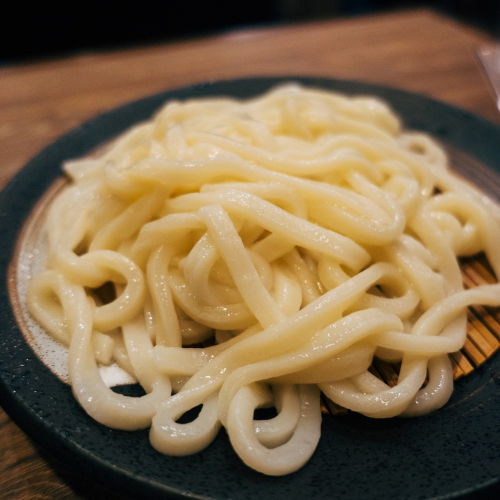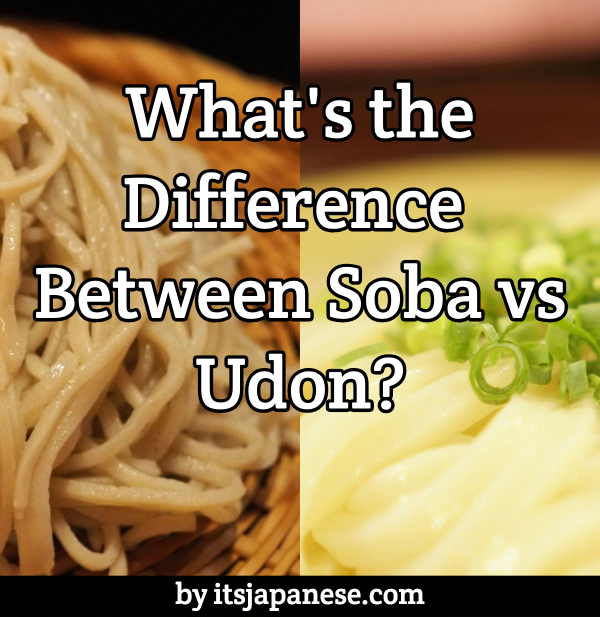Wondering about Soba vs. Udon?
Which is healthier?
Which is tastier? And what’s the difference between Soba vs Udon?
This is the Sobs vs. Udon guide for you — you’ll know all about ’em.
Soba vs. Udon Overview
There are various types of Japanese noodles… with unique characteristics and cultural significance.
But, of all noodle types in Japan, the two most important are…
…udon and soba.
Udon is characterized by being made entirely of wheat and soba uses buckwheat for a special texture and flavor.
What is Soba?
Soba noodles are a traditional type of noodle known for their texture and nutty flavor.
The noodles are made mostly of buckwheat flour which gives it a brown color, unique flavor, and texture.
As such, Soba noodles can be good for those on a gluten-free diet — no added wheat flour.
As for making soba noodles from scratch…
Well, that can take years of practice.
It is a particularly tricky noodle to master due to the noodle dough’s consistency.
Soba Noodle History
In Japan, soba noodles have a long history dating back to the Edo period during the 17th to 18th centuries.
Soba was originally a lower-class food that gained popularity among all class levels.
As soba noodles gained popularity, it was common to see soba shops in every Tokyo city block — in both casual restaurants to street stalls.
(If you want to get Soba for yourself…
…you can definitely find some on Amazon (click here to see Soba on Amazon.))
Types of Soba noodle dishes:
Zaru Soba: This is a style of soba noodle where it is served cold on top of a bamboo mat with a dipping sauce on the side made from dashi, soy sauce, and mirin.
Kake Soba: Kake means “cover” and this soba noodle dish is served hot and covered in a broth made from dashi, soy sauce, and mirin. Additionally, it might be topped with green onions and tempura crumbs.
Tempura Soba: This soba noodle dish is almost the same as kake soba but topped with crispy tempura. The crispy tempura soaks up the broth and adds a delicious flavor and texture to the entire dish.
Tsukimi Soba: Tsukimi means moon-viewing in Japanese and it is a soba noodle that is served hot with broth. The moon-viewing element comes from an egg that is poached inside the broth that can resemble the moon.
Kamo Namban: This soba noodle dish is unique because it is served hot with duck breast and green onions. It is a delicious and hearty way to eat soba noodles.
Wakame Soba: Wakame is a type of seaweed that is often used in miso soup. This version of soba noodles is served hot and topped with wakame seaweed for a delicious texture and flavor.
What is Udon?

Udon noodles are thicker shape noodles and are quite chewy.
Udon is made mostly of wheat flour and water.
Flavor-wise, udon noodles tend to have a more neutral flavor that works in a wide variety of dishes.
Udon Noodle History
Udon is thought to originate from China and it was introduced to Japan during the 8th century.
Similar to soba, its popularity increased during the Edo period of the 17th – 18th centuries.
In modern Japan, it is a comfort food that is a central part of Japanese cuisine that can be found all across the country.
It has also gained popularity outside of Japan and you can find it in restaurants around the world.
(Also, if you want to get Udon for yourself…
…you can definitely find some on Amazon (click here to see Udon on Amazon.))
Udon Noodle Dishes:
Yaki Udon: This is a unique variation of udon noodles which are fried with vegetables, meat, and yakisoba sauce. Compared to yakisoba, the udon noodle’s thickness gives it a chewier texture.
Kitsune Udon: This type of udon noodle dish is served hot topped with a flavorful fried tofu. The broth is made from a combination of dashi, soy sauce, and mirin.
Tanuki Udon: In this variety of udon noodle dishes, the udon is served hot topped with tempura crumbles that soak up the broth and give it a fattier flavor.
Zaru Udon: Just like with soba, udon can also be served cold as zaru udon. It comes with a dipping sauce on the side. When udon is served cold you can appreciate the springy texture of the noodles.
Chikara Udon: Chikara means is how you say strength or power in Japanese. In this variation of udon, it is topped with toasted mochi or rice cakes. Since it has carbohydrates from both the noodles and the mochi, it can give you more “strength”!
Curry Udon: A popular udon dish is curry udon where instead of the traditional soy sauce broth, the broth is flavored with Japanese curry sauce. The flavorful curry works well with the thick noodles of udon.
Comparing Udon vs Soba
So, what’s the difference between udon and soba?
Ingredients:
The biggest difference between soba and udon is in their ingredients.
Udon is made mostly of wheat flour and soba is made mostly of buckwheat flour.
The buckwheat is what gives udon a unique flavor and grainy texture.
Udon tends to have a neutral flavor with a smoother and chewy texture.
Eating Style:
In general, soba noodles are served with minimal additional flavors to enhance the distinct flavor and texture of the noodles.
On the other hand, udon noodles can be embellished with more flavors such as curry udon or yaki udon because it has a more neutral flavor.
However, they also share many of the same serving styles such as with zaru udon and zaru soba which are both served cold with a dipping sauce.
When to Eat:
Soba noodles and udon noodles are both popular year-round because they can be served both hot and cold.
One big difference could be that Japanese people traditionally eat soba during New Year’s to signify letting go of the past and embracing the future.
Which is Healthier?
Soba vs Udon — which one should you go for?
For nutritional content, soba noodles are healthier than udon noodles because soba has more nutrients.
Soba consists mainly of buckwheat which is rich in vitamins like B1, B2, and B3.
It is also a good source of protein and fiber.
In the past, soba noodles were also important for preventing beriberi which was caused by too little thiamine.
Soba noodles were used as a way to prevent this kind of nutritional deficiency.
Udon noodles are lower in nutrients but they can also provide health benefits because they are traditionally served in a lean broth with different ingredients on top.
If you are on a gluten-free diet, you should be careful because udon noodles contain wheat flour.
In that case, soba noodles could be a better choice as it is possible to find gluten-free options.
Back to You
Now you know a bit about Soba vs Udon.
Which one is healthier (Soba)…
Which one to avoid if you’re gluten-free (Udon…
And which one is tasty.
Now back to you — which do you prefer? Leave a comment.
– Team IJ














